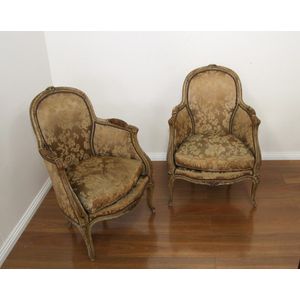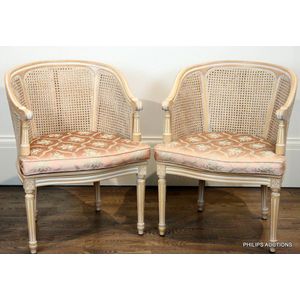Louis XVI style cane back tub chairs with salmon squabs
A pair of pale timber Louis XVI style cane back tub chairs, later 20th century, with double layer hole to hole cane backs and seats, fluted arm supports and conforming tapering legs with paterae details, with salmon pink trellis pattern squabs with mint and champagne flowers, height 83 cm, width 62 cm, depth 63 cm
You must be a subscriber, and be logged in to view price and dealer details.
Subscribe Now to view actual auction price for this item
When you subscribe, you have the option of setting the currency in which to display prices to $Au, $US, $NZ or Stg.
This item has been sold, and the description, image and price are for reference purposes only.
- Patera - A small decorative device, used as ornament in Neo-classical style furniture. Patera (or paterae) are usually round or oval, in the form of stylized rosettes. In the best pieces they are carved directly into the timber, otherwise they applied to the surface. Sometimes painted or inlaid motifs in the style are referred to as patera. Also known as a boss or a rosette.
- Fluting - A form of decoration found on many pieces of furniture, as well as ceramics, silver and clocks, in which round-bottomed grooves, of varying width and depth, are let into columns, pilasters, legs. As a general rule, flutes are cut in the vertical, though they may follow a turned leg in a spiral pattern. In cross-section, they may be described as a series of 'U' shapes, rising and narrowing at each end of the groove. Fluting is the opposite of reeding, with which fluting is often associated.
- Cane in Furniture Making - Cane, as used to make furniture is harvested from the ratan palm. The rattan palm is a type of climbing palm that is native to tropical regions of Asia and Africa. The stem of the rattan palm, also known as cane, is harvested, stripped of its skin, and then used to make a variety of furniture items. Rattan furniture is known for its durability, lightness and natural beauty. The cane is flexible yet strong and can be woven into various patterns, making it suitable for a wide range of furniture styles from traditional to modern. The furniture made from rattan cane is also known for its durability and resistance to extreme weather conditions. Popular items include chairs, tables, sofas, and cabinets. The natural colour of the cane can be preserved or it can be stained or painted for different looks.
This item has been included into following indexes:
Visually similar items

Pair of French Louis XVI style caned arm chairs (2)
Sold by
in
for
You can display prices in $Au, $US, $NZ or Stg.

A pair of French 19th century painted and floral upholstered bergere chairs. 86 cm high, 56 cm wide.
Sold by
in
for
You can display prices in $Au, $US, $NZ or Stg.

A pair of children's painted and upholstered armchairs
Sold by
in
for
You can display prices in $Au, $US, $NZ or Stg.

A pair of French carved walnut wingback armchairs, 19th century, covered in original delicate floral jacquard
Sold by
in
for
You can display prices in $Au, $US, $NZ or Stg.
